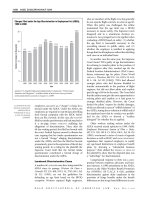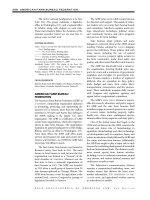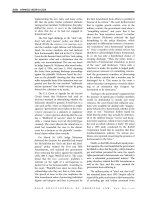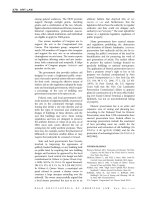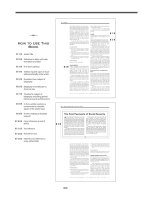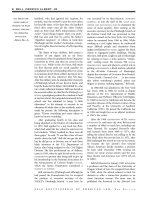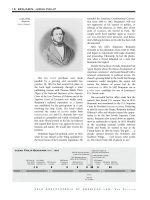Gale Encyclopedia Of American Law 3Rd Edition Volume 2 P32 pptx
Bạn đang xem bản rút gọn của tài liệu. Xem và tải ngay bản đầy đủ của tài liệu tại đây (246.9 KB, 10 trang )
Controversy over the role of government
support of the arts arose in the late 1980s with
two artists who received NEA funding. In 1988
the photographer Andres Serrano received
harsh condemnation for his photograph titled
Piss Christ, which depicted a plastic crucifix
floating in a jar of Serrano’s urine. Numerous
senators sent letters of protest to the NEA,
insisting that the agency cease underwriting
vulgar art. A second furor arose in 1989 over the
work of another photographer, Robert Map-
plethorpe, who received NEA support for his
work, which depicted flowers, nude children,
and homosexuality and sadomasochism.
Senator
JESSE HELMS (R-N.C.) argued the
most vociferously against the NEA choices and
introduced legislation to ban funding of “ob-
scene or indecent art” (1989 H.R. 2788 [codified
at 20 U.S.C.A. §§ 953 et seq.). The Helms
Amendment, adopted in October 1989, gave the
NEA gr eat power and latitude to define
obscenity and
QUASH alternative artistic visions.
To enforce the new amendment, the NEA
established an “obscenity pledge,” which re-
quired artists to promise they would not use
government money to create works of an
obscene nature. The art world strongly resisted
this measure: Many museum directors resigned
in protest, and several well-known artists
returned their NEA grants.
Two important cases tested the power of the
NEA to censor artistic production. In Bella
Lewitsky Dance Foundation v. Frohnmayer, 754
F. Supp. 774 (C.D. Cal. 1991), a dance company
refused to sign the obscenity pledge and sued on
the ground that the pledge was unconstitution-
al. A California district court agreed that the
pledge violated the First Amendment right to
free speech and that its vagueness denied the
dance company due process under the
FIFTH
AMENDMENT
.
In New School v. Frohnmayer, No. 90-3510
(S.D.N.Y. 1990), the New School for Social
Research, in New York City, turned down a
grant, claiming that the obscenity pledg e acted
as
PRIOR RESTRAINT and, therefore, breached the
school’s First Amendment rights. Before the
constitutionality of the prior restraint argument
was decided, the NEA released the school from
its obligation to sign the pledge.
The NEA abolished the obscenity pledge in
November 1990, but in its place instituted a
“decency clause” (1990 Amendments, Pub. L.
No. 101-512, § 103(b), 104 Stat. 1963 [codified
at 20 U.S.C.A. § 954(d)]), which required award
recipients to ensure that their works met certain
standards of decency. Failure to comply with
this demand could mean suspension of grant
payments.
Again the art world protested. In Finley v.
NEA, 795 F. Supp. 1457 (C.D. Cal. 1992), artists
known as the NEA Four—Karen Finley, John
Fleck, Holly Hughes, and Tim Miller—sued the
NEA over the decency clause. A California
district court agreed with the artists. The Finley
court held that the decency clause, like the
obscenity pledge, was unconstitutional because
its vagueness denied the artists the due process
guaranteed by the Fifth Amendment and
because its too-general restriction suppressed
speech.
Books
U.S. parents send their children to public
schools to receive an education and to learn
the fundamental values on which their demo-
cratic society is based. Conflict ensues when
parents believe that certain schoolbooks contain
material that is objectionable on political,
moral, or religious grounds and should be
banned in order to protect their children from
exposure to allegedly harmful ideas. In so me
instances school boards have responded by
physically removing books from school library
shelves. In ge neral, advocates of book banning
maintain that censorship is w arranted to
redress social ills, whereas critics believe that
freedom of speech is more important and
useful to society than imposing values through
censorship.
Book banning as a way to remedy social
problems was first tested by the Supreme Court
in Board of Education v. Pico, 457 U.S. 853, 102
S. Ct. 2799, 73 L. Ed. 2d 435 (1982). In Pico,
parents objected to nine books in the high
school library, most of which were subsequently
removed by the school board. The nine books
were Slaughterhouse Five, by Kurt Vonnegut Jr.;
Naked Ape, by Desmond Morris; Down These
Mean Streets, by Piri Thomas; Best Short Stories
of Negro Writers, edited by Langston Hughes;
Laughing Boy, by Oliver LaFarge; Black Boy, by
Richard Wright; A Hero Ain ’t Nothin’ But a
Sandwich, by Alice Childress; Soul on Ice, by
ELDRIDGE CLEAVER; and Go Ask Alice, by an
anonymous author.
GALE ENCYCLOPEDIA OF AMERICAN LAW, 3RD E DITION
298 CENSORSHIP
Pico debated the authority of local school
boards to censor material in the interest of
protecting students. The case reached the Su-
preme Court because lower courts were unable to
devise standards for testing the constitutionality
of book removal. The Supreme Court ruled that
it is unconstitutional for public school boards to
abridge students’ First Amendment rights by
banning books. Although school boards have
the power to determine which books should
sit on library shelves, they do not have the
authority to censor.
Books published by commercial presses for
sale to the general public sometimes meet with
harsh condemnation and subsequent action
that could be tantamount to censorship. In
November 1990, Simon and Schuster canceled
its contract with author Bret E. Ellis to publish
his novel American Psycho, citing the work’s
graphic violence and sexual brutali ty. The
National Writers Union decried the cance llation
as censorship because it was contrary to free
speech and artistic expression. The publishing
house defended its editorial judgment by
claiming it did not want to put its imprint
on a book of questionable taste and value.
Vintage Books, a division of Random House,
soon acquired the novel, and published it in
March 1991.
Students’ Speech
Students’ free speech rights sometimes clash
with schools’ interest in maintaining control of
public education. Students’ First Amendment
rights were affirmed by the landmark Tinker v.
Des Moines Independent Community School
District, 393 U.S. 503, 89 S. Ct. 733, 21 L. Ed.
2d 731 (1969), which ruled that public school
students could not be penalized for wearing
symbols, such as black armbands, to protest the
VIETNAM WAR.
Two subsequent cases dealing with issues of
censorship in school newspapers pointed to a
more restrictive judicial view of students’ right
to free expression. In Hazelwood School District
v. Kuhlmeier, 484 U.S. 260, 108 S. Ct. 562, 98 L.
Ed. 2d 592 (1988), the Supreme Court ruled
in favor of a Hazelwood, Missouri, school
principal who removed several articles from a
student newspaper. The articles dealt with teen
pregnancy and a student’s feelings about her
parents’
DIVORCE. The Court in Hazelwood held
that a school newspaper is not a public forum
and thus granted school officials the right to
determine what type of student speech is
appropriate and to regulate such speech.
Three years later, the ruling in Planned
Parenthood v. Clark County School District, 941
F.2d 817 (9th Cir. 1991), was based on Hazel-
wood. In Plann ed Parenthood, a public high
school newspaper solicited advertisements
from local businesses, including Planned Par-
enthood. The princ ipal refused to allow Planned
Parenthood to place an advertisement in school
publications, and Planned Parenthood sued the
school distric t. The Ninth
CIRCUIT COURT of
Appeals upheld a district court decision that a
public high school publication is not a public
forum and that the school could, therefore,
accept or reject advertisements. Both Hazelwood
and Planned Parenthood concluded that because
public high schools are nonpublic forums,
school districts can apply a limited degree of
censorship.
Hundreds of public universities in the United
States have speech codes to regulate students’
choice of words. Speech can be constitutionally
curtailed in some circumstances. For example,
public
COLLEGES AND UNIVERSITIES can forbid
threats of violence, prohibit obscene language
A student displays
two books that were
banned from a local
high school’s English
classes when parents
voiced disapproval
of the content.
AP IMAGES
GALE ENCYCLOPEDIA OF AMERICAN LAW, 3
RD E DITION
CENSORSHIP 299
and conduct (although it is extremely difficult
to define or prove obscenity ), and punish
students for using defamatory speech against
each other, all without violating the First
Amendment. Numerous cases have successfully
contested free speech limitations on campus,
suggesting that a majority of these codes are
unconstitutional.
In Doe v. University of Michigan, 721 F.
Supp. 852 (E.D. Mich. 1989), a biopsychology
student maintained that the university’s speech
code prevented him from freely discussing
controversial ideas about biologically based
differences between the sexes and races. A
district court ruled that the university’scode
proscribed too great a range of speech and,
therefore, was an unconstitutional infringement
on the plaintiff’s First Amendment right s. The
court also held that the overbroad nature of the
code denied his due process rights.
A University of Wisconsin student was
accused of violating the univer sity’s speech
codes by yelling rude comments at a woman.
In U.W.M. Post, Inc. v. Board of Regents, 774 F.
Supp. 1163 (E.D. Wis. 1991), the university’s
speech code was also struck down as overbroad.
Two years later, school officials punished
fraternity brothers at
GEORGE MASON University
for dressing in drag and staging an “ugly woman
contest.” In Iota X Chapter v. George Mason
University, 993 F.2d 386 (1993), the Fourth
Circuit found that the university had violated
the First Amendment because it did not
sanction the fraternity merely for its conduct,
but rather for the message conveyed by the
“ugly woman contest,” which ran counter to the
views the university sought to foster.
The Internet and Computer-Related
Technologies
Computer-mediated c ommunication grows
sharply every year and in some ways outpaces
and obviates current legal principles. The
prevailing concept of law applies to real-world
events and transactions, and, as those in the
legal field are realizing, may unravel when
exercised in cyberspace. As more and more
people transmit widely divergent messages on
the electronic highway, issues of free speech and
censorship become increasingly complicated
and regulations difficult to enforce.
The first case of criminal prosecution
of electronic communication involved the
distribution of pornography over an electronic
bulletin board system (BBS). In United States
v. Thomas, No. CR-94-20019-G (W.D. Tenn.
1994), Robert Thomas and Carleen Thomas
were found guilty of disseminating obscene
materials by interstate telephone lines and
computer. From their home in California, the
Thomases ran an adults-only private BBS from
which subscribers could download computer
graphics files and order sexually explicit photo-
graphs and videotapes while online. To gather
evidence against the couple, a Memphis postal
inspector, under an assumed name, down-
loaded to his computer many of the porno-
graphic electronic files and ordered tapes.
The Thomases were charged with, among
other actions, transporting obscene materials
across state lines. The couple attempted to
transfer their case to the Northern District of
California, so that their materials would be
measured against that community’s standards
of obscenity, rather than the obscenity stan-
dards of the Western District of Tennessee. The
district judge denied their request, noting that
in obscenity prosecutions the trial can be held
either in the district from which the material
was sent or the one in which it was received.
Similar
INTERNET and censorship issues
regarding
CHILD PORNOGRAPHY were raised in
the April 2009 case involving a 38-year-old
employee of the Seattle Children’s Theatre
(SCT). William Edgar Hoke was accused of
obtaining child pornography from an interna-
tional Internet bulletin board on which mem-
bers exchanged pornographic images. Tipped
off by European Union auth orities, the U.S.
Postal Inspection Office began investigating the
site in 2007, and it determined some 545
members were registered with the Internet
business. This investigation led U.S. authorities
to Hoke, who had used his home computer and
the one at the theater to access the bulletin
board. The SCT cooperated with the investiga-
tion, explaining that its employees undergo a
background check and must sign a contract
regarding the theater’s policy concerning con-
duct with minors.
The “virtual” nature of cyberspace poses a
number of problems for courts and legislatures
on the issue of obscenity. Among the most
difficult of these is the issue of community
standards. Because the Internet brings together
people from all over the United States and all
GALE ENCYCLOPEDIA OF AMERICAN LAW, 3RD E DITION
300 CENSORSHIP
over the world, it defies identification with any
particular community. Other difficulties are
connected to the criminal element of knowledge
and the issue of dissemination. Persons may
post and receive information on Internet
bulletin boards without the knowledge of those
who maintain the BBS, making it difficult
to determine whether the BBS operators
“knowingly disseminated” obscene materials.
Congress has attempted to restrict the
dissemination of indecent material found on
the Internet, but several of these efforts have
been struck down by the Supreme Court. In
1996 Congress passed the Communications
Decency Act (CDA) in an effort to regulate
content found on the Internet to protect
children from harmful content. However, in
Reno v. ACLU, 521 U.S. 844, 117 S. Ct. 2329,
138 L. Ed. 2d 874 (1997), the Court struck the
statute down, holding that law was overbroad
and constituted a content-based blanket restric-
tion on speech.
In 1998 Congress enacted the Child Online
Protection Act (COPA), which was a dire ct
response to the Court’s 1996 decision. COPA
made it illegal to use the World Wide Web to
communicate “for commercial purposes” any
material considered to be “harmful to minors.”
The law also incorporated the three-part
obscenity test that the Supreme Court formu-
lated in Miller v. California. Several parties
challenged the statute, leading to the Court’s
opinion in Ashcroft v. American Civil Liberties
Union, 535 U.S. 564, 122 S. Ct. 1700, 152 L. Ed.
2d 771 (2002). The confusing decision, which
produced five separate opinions, offered lit tle
solid guidance about the appropriate standard
to judge whether a statute overly restricts
Internet content. The Court remanded the case
for a full examination of the law on all issues.
A month later, the Court in Ashcroft v. Free
Speech Coalition, 535 U.S. 234, 122 S. Ct. 1389,
152 L. Ed. 2d 403 (2002) ruled that the definition
of “child pornography” in the Child Pornogra-
phy Prevention Act (CPPA), 18 U.S.C.A. § 2256
was overbroad. The CPPA defined child por-
nography to include not only real children but
also virtual representations of children. The
Court concluded that allowing such a broad
definition could lead to regulation of protected
works, such as William Shakespeare’s Romeo
and Juliet and the Academy Award winning film
American Beauty, both of which contain story
lines of minors having sex.
The U.S. government has long been con-
cerned about the impact of emerging tech-
nologies on its ability to regulate undesirable
communications. Given the invention of radio
and telephonic communications during the late
nineteenth century and the nascent deve lop-
ment of television during the late 1920s and
early 1930s, Congress passed the Communica-
tions Act of 1934 (47 U.S.C. §§ 151 et seq.),
which created the Federal Communications
Commission (FCC) to help oversee this area
of the law. The successor to the Federal Radio
Commission, the FCC is charged with regulat-
ing interstate radio, television, wire, wireless,
satellite, and cable communications, as well as
all international communications that originate
or terminate in the United States. The FCC’s
jurisdiction extends to all 50 states, the District
of Columbia, and United States possessions.
The FCC is independent of the
EXECUTIVE BRANCH
and is directly responsible to Congress.
At a high level, the FCC is responsible for
the orderly development and operation of
broadcast services, provision of rapid and
efficient communication services at reasonable
rates, promotion of competition among com-
munication providers, and strengthening of
national defense. The commission’s primary
tools include the power to issue and revoke
broadcast licenses, make rules, investigate and
adjudicate disputes, issue orders, and publish
findings. The FCC’s Office of Strategic Planning
and Policy Analysis is charged with the duty of
staying abreast of technological developments in
the marketplace and devising strategies to make
sure the law adapts to those developments.
FURTHER READINGS
Bussian, James R. 1995. “Anatomy of the Campus Speech
Code: An Examination of Prevailing Regulations.”
South Texas Law Review 36 (February).
Butler, Deborah A. 1992. “Planned Parenthood of Southern
Nevada v. Clark County School District: The Evolution
of the Public Forum Doctrine.” Wayne Law Review 38
(summer).
Byassee, William S. 1995. “Jurisdiction of Cyberspace:
Applying Real World Precedent to the Virtual Com-
munity.” Wake Forest Law Review 30 (spring).
“The Call to Campus Conduct Policies: Censorship or
Constitutionally Permissible Limitations on Speech.”
1990. Minnesota Law Review 75 (October).
Couvares, Francis G., and Charles Musser. 1996. Movie
Censorship and American Culture. Washington, D.C.:
Smithsonian Institution Press.
Foerstel, Herbert N. 2002. Banned in the U.S.A.: A Reference
Guide to Book Censorship in Schools and Public Libraries.
Rev. ed. Westport, CT: Greenwood Press.
GALE ENCYCLOPEDIA OF AMERICAN LAW, 3RD E DITION
CENSORSHIP 301
Kolbert, Kathryn, and Zak Mettger. 2002. Justice Talking:
Censoring the Web: Leading Advocates Debate Today’s
Most Controversial Issues. New York: New Press.
Lambe, Jennifer L. 2008. “The Structure of Censorship
Attitudes.” Communication Law and Policy. Autumn.
Madved, Lory. 1992. “Protecting the Freedom of Speech
Rights of Students: The Special Status of the High
School Library.” Capital Univ. Law Review 21 (fall).
Orbach, Barak Y. 2009 “Prizefighting and the Birth of Movie
Censorship.” Yale Journal of Law and the Humanities.
Summer.
Schlegel, Julia W. 1993. “The Television Violence Act of
1990: A New Program for Government Censorship?”
Federal Communications Law Journal 46 (December).
Strossen, Nadine. 1996. Defending Pornography: Free Speech,
Sex, and the Fight for Women’s Rights. New York:
Anchor Books.
Walker, Michael W. 1993. “Artistic Freedom v. Censorship:
The Aftermath of the NEA’s New Funding Restrictions.”
Washington Univ. Law Quarterly 71 (fall).
CROSS REFERENCES
Art Law; Child Pornography; En tertainment Law; First
Amendment; Freedom of Speech; Freedom of Press; Movie
Rating; Prior Restraint; Schools and School Districts.
CENSURE
A formal, public reprimand for an infraction or
violation.
From time to time deliberative bodies are
forced to take action against members whose
actions or behavior runs counter to the group’s
acceptable standard s for individual behavior. In
the U.S. Congress, that action can come in the
form of censure. Censure is a formal and public
condemnation of an individual’s transgressions.
It is stronger than a simple rebuke, but not as
strong as expulsion. Members of Congress who
have been censured are required to give up any
committee chairs they hold, but they are not
removed from their elected position. Not
surprisingly, however, few censured politicians
are re-elected.
While censure is not specifically mentioned
in the U.S. Constitution, Congress has the right
to adopt resolutions, and a resolution to invoke
censure falls into this category. The first use of
censure was actually directed not at a member
of Congress but at a member of George
Washington’s cabinet.
ALEXANDER HAMILTON,
Washington’s treasury secretary, was accused
of mishandling two congressionally authorized
loans. Congress voted a censure resolution
against Hamilton. The vote fell short, but it
established censure as a precedent. In general,
each house of Congress is responsible for
invoking censure against its own members;
censure against other government officials is not
common, and censure against the president is
rarer still.
Because censure is not specifically men-
tioned as the accepted form of reprimand, many
censure actions against members of Congress
may be listed officially as rebuke, condemna-
tion, or denouncement. The end result, howev-
er, is the same, and to all intents and purposes
these are censure measures. At the same time,
each censure case is different, and those
delivering censure like to have enough leeway
to tailor the level of severity. Still, the prospect of
an open, public rebuke by one’s peers is painful
even for the most thick-skinned politician.
Noteworthy Censure Cases
Among the best known censure cases in
Congress were the 1811 censure of Massachu-
setts senator Timothy Pickering for reading
confidential documents in Senate sessions and
the 1844 censure of Ohio senator Benjamin
Tappan for releasing a confidential document to
a major newspaper. Perhaps one of the more
colorful censure motions was the 1902 censure
of South Carolina’s two senators, Benjamin R.
Tillman and John L. McLaurin. On February 22,
1902, they began fighting in the Senate
chamber. Both men were censured and sus-
pended for six days (retroactively).
Probably the most infamous censure case
was the condemnation of Senator
JOSEPH R.
MCCARTHY (R-Wisc.) in 1954. McCarthy took the
national stage at the height of the anti-
Communist movement following
WORLD WAR II.
McCarthy spent several years making claims
that known Communists had infiltrated the U.S.
government, and although he never offered
proof of even one claim, his crusade was
popular and powerful. Many Americans from
all walks of life saw their lives destroyed in the
early 1950s by groundless accusations of com-
munist sympathies. His power unchecked,
McCarthy became even more relentless, and in
1954 when he openly attacked members of the
Eisenhower administration in televised hearings.
His colleagues realized they had no choice but to
act. A censure committee was formed, and
McCarthy as much as accused its members of
being Communists. The vote to condemn
McCarthy passed 65 to 22 on December 2, 1954.
Robert Torricelli (D-N.J.) was found guilty
in 2002 of taking illegal gifts and cash payments
GALE ENCYCLOPEDIA OF AMERICAN LAW, 3RD E DITION
302 CENSURE
from a businessman and not reporting them.
The businessman got help from the senator in
LOBBYING the government. Although Torricelli
denied the charges, his colleagues found the
evidence compelling enough to “severely ad-
monish” him. While not called a “censure,” this
reprimand clearly had the same effect. Torri-
celli, who was up for reelection, saw his
popularity plunge in a matter of weeks, and
on September 30, 2002 , he withdrew from the
race.
Presidential Censure
Congress rarely acts against the president with a
formal reprimand.
ANDREW JACKSON was the first
president to be thus reprimanded, by the Senate
in 1834, after he removed the secretary of the
treasury (a responsibility that Congress believed
rested with the legislature). Jackson was a
Democrat, but the Senate was controlled by
the rival
WHIG PARTY. Three years later, when the
Democrats took control of the Senate, Jackson’s
censure was expunged from the records.
President
JOHN TYLER was reprimanded in
1842 by the House of Representatives, which
accused him of abusing his powers. Apparently
Tyler had promised representatives on several
occasions that he would support certain bills,
only to
VETO them when they arrived at his desk.
In 1848, President
JAMES K. POL K was repri-
manded by the House for starting the Mexican
War without first obtaining Congressional
approval. In 1864, President
ABRAHAM LINCOLN
and his secretary of war, EDWIN STANTON, were
condemned by the Senate for allowing an
elected member of the House to hold commis-
sions in the Army. The Senate voted for the
reprimand 24 to 12, but it was referred to a
special committee and no further action was
taken.
In 1998, during the
IMPEACHMENT trial of
President
BILL CLINTON, several members of Con-
gress attempted to have him censured instead,
believing that while his behavior warranted
rebuke it did not merit a full impeachment.
The move for censure failed, and Clinton was
impeached.
FURTHER READINGS
Congressional Quarterly. “Congressional Ethics: History,
Fact, and Controversy.” 1992. Washington, D.C.:
Congressional Quarterly.
Thompson, Dennis F. 1995. Ethics in Congress: From
Individual to Institutional Corruption. Washington,
D.C.: Brookings Institution.
U.S. House of Representatives. Committee on Standards of
Official Conduct. Available online at se.
gov (accessed August 29, 2009).
CROSS REFERENCES
Congress of the United States; Impeachment.
CENSUS
A census is an official count of the population of a
particular area, such as a district, state, or nation.
The U.S. Constitution requires that a census
of the entire population, citizens and nonciti-
zens alike, be made every ten years (Article I,
Section 2, Clause 3). The
FOURTEENTH AMEND-
MENT
to the Constitution directs that the census
will be used to determine the number of
members of the U.S. House of Representatives
from each state. The census is conducted by the
U.S. Census Bureau, an agency established in
1899 within the U.S.
COMMERCE DEPARTMENT. The
data gathered by the U.S. Census Bureau are
used by the states to draw boundaries for
congressional and state legislat ive districts, and
by local governments to establish districts for
other representative bodies such as county
legislatures, city councils, and boards of super-
visors.
Census data are also used to allocate federal
and state funding and services. By the mid-
1990s more than $50 billion in federal aid for
education, housing, and health programs to
states and cities was distributed annually based
on census numbers. In addition, census infor-
mation is used in academic research and is
sought by product manufacturers and market-
ers who want to know the demographics of
potential consumers.
The first U.S. census took place in 1790
when some 600 U.S. marshals went door-
to-door counting approximately 3.9 million
people. The 1790 census consisted of fewer
than ten questions, which for each household
included the name of the head of the family, the
number of free white males over and under 16
years of age, the number of free white females,
the number of all other free persons, and the
number of slaves.
The 1890 census counted 63 millio n U.S.
citizens and reflected a dramatic increase in
IMMIGRATION, urbanization, and industrializa-
tion. That census showed t hat for the first time
fewer than half of all U.S. workers were
employed on farms. The 1890 census included
GALE ENCYCLOPEDIA OF AMERICAN LAW, 3RD E DITION
CENSUS 303
questions regarding military service during the
Civil War, number of years in the United States,
NATURALIZATION status, reading and writing
ability, and mental and physical disabilities.
By 1980 the Census Bureau conceded that
the decennial censuses were underc ounting
portions of the population, usually low-income
and minority groups in the inner cities. In
follow-up surveys after the 1980 census, the
bureau determined that it had missed some 3.2
million persons, or 1.4 percent of the popula-
tion. For example, a 1986 post-census survey of
East Los Angeles estimated that the 1980 census
missed about 10 percent of the Latino commu-
nity, 7 percent of the Asian community, and
9 percent of the African American community.
Census offici als determined that overall, nearly
6 percent of the African American and Hispanic
populations were uncounted and less than
1 percent of the white population.
By May 1987 the Census Bureau had
determined that the 1990 census could be
adjusted for undercounting by using a tech-
nique called a post-enumeration survey (PES).
The PES would allow the census to be checked
for accuracy by sending census takers back to a
given number of househo lds that would be
representative of the entire U.S. population and
comparing the information gathered with the
initial head count. If discrepancies arose, the
bureau could make corrections and project
them to neighborhoods with similar demo-
graphic characteristics.
But in October 1987 officials from the
Commerce Department, which oversees the
Census Bureau, decided against making any
statistical adjustment to the 1990 census. As a
result, in 1988 New York, Los Angeles, and
several other cities, as well as a number of states
and organizations, brought suit in federal district
court. They claimed that the secretary’s decision
not to adjust the 1990 census violated their right
to
EQUAL PROTECTION under the FIFTH AMENDMENT
to the Constitution and asked the court to
enjoin the census. They also argued that the
Commerce Department’s actions were politically
motivated by a Republican administration that
realized that the undercounted population is
historically Democratic. The defendants moved
to dismiss the complaint, contending that the
secretary’s decision was not subject to
JUDICIAL
REVIEW
.InCity of New York v. United States
Department of Commerce (713 F. Supp. 48
[E.D.N.Y. 1989]), the district court denied the
motion to dismiss, holding that the plaintiffs
had standing (the
LEGAL RIGHT) to challenge
the census on constitutional grounds and that
the court could review the secretary’s decision.
Following the district court’s decision, the
parties entered into a stipulation in July 1989 by
which plaintif fs would withdraw their motion
to enjoin the census and the Commerce
Department would reconsider its 1987 decision
not to adjust the 1990 census. The agreement
required the Commerce Department to conduct
a PES of not fewer than 150,000 households as
part of the 1990 census in order to produce
corrected counts usable for congressional and
legislative reapportionment and redistricting.
The agreement also required the department to
develop guidelines under which the secretary
would assess any proposed adjustment. In
March 1990, the Commerce Department issued
final guidelines. The plaintiffs challenged them
in court on the grounds that they were
impermissibly vague and were biased against
any adjustment to the 1990 census. In City of
New York (739 F. Supp. 761 [E.D.N.Y. 1990]),
the district court held that the guidelines
satisfied the defendants’ obligations under the
1989 stipulation. The Census Bureau then
began the 1990 census.
The 1990 census employed more than
425,000 workers who gathered information on
an estimated 250 million people in 106 million
households. For the first time, the Census
Bureau combined technology with traditional
door knocking, using coast-to-coast computer-
ized maps of all 7.5 million census tracts in the
Census workers in a
Phoenix, Arizona,
data capture center.
For the 2000 Census,
the bureau planned to
hire 850,000
temporary employees
to assist its
6,000 permanent
employees.
U.S. CENSUS BUREAU
GALE ENCYCLOPEDIA OF AMERICAN LAW, 3
RD E DITION
304 CENSUS
United States. The bureau predicted that these
maps would reduce the number of errors
caused by census workers’ reliance on outdated
state and local maps. The census cost some
$2.6 billion—65 percent more than the 1980
census—making it the most expensive count
ever conducted.
In March 1990 the bureau mailed or hand
delivered more than 106 million questionnaires,
one to every household in the United States.
Most households received a short form
consisting of 14 questions covering personal
characteristics and housing. One in six U.S.
households received a long form with 45 addi-
tional questions on topics such as utilities, tax,
MORTGAGE, and rent payments; place of birth;
ethnic origin; and work habits. From March to
June 1990, census workers continued the data
collection. The bureau set aside March 20, 1990,
as homeless night. On that night, census takers,
many hired from among the homeless popula-
tion or those who worked with them, visited
shelters and low-cost motels from 6:00 p.m. to
midnight; counted homeless people on the
streets from 2:00 a.m. to 4:00 a.m.; and from
4:00 a.m. to 6:30 a.m. stood outside abandoned
buildings, counting those who emerged.
The homeless count caused a great deal of
controversy. The 1990 census reported 228,600
homeless persons in the United States, com-
pared with earlier estimates of 500,000 to
3 million. Advocates for homeless persons argued
that the Census Bureau had surveyed only one-
third of the country’s cities and counties and
had visited only a limited number of locations.
The bureau acknowledged that its workers had
avoided actually going into hideaways such as
abandoned buildings and dumpsters because of
safety concerns and admitted that many winter
shelters had closed by the time the census was
taken in late March. The bureau maintained
that its homeless survey was not intended to
produce a definitive count of the homeless
population.
In October 1990 the Census Bureau issued
estimated U.S. population figures of approxi-
mately 254 million, based on a tracking of birth,
death, and immigration records. In December
the bureau released a final U.S. population tally
of some 249 million, based on the actual mailed
census questionnaires and house-to-house
interviews. The discrepancy between the two
sets of numbers indicated that the 1990 census
missed some five million U.S. residents.
By December 31, 1990, the bureau reported
to the president population figures for each
state as well as the number of seats in the U.S.
House of Representatives that each state would
receive. Between January and March 1991,
states with early deadlines for redrawing
legislative districts received totals of all persons
of voting age, broken down by race. By April 1,
1991, most other states received the voting age
and race data. Between April 1991 and 1993, the
Census Bureau released statistics compiled from
the long forms, including information on
income, marital statu s, disabilities, types of
housing, and education.
In April 1991 the bureau announced the
results of its PES. Estimates drawn from the PES
revealed that the census had resulted in a
national undercount of 2.1 percent, or approxi-
mately 5.3 million persons out of a total
population of approximately 255 million, the
largest undercounting in the history of the
census. For example, in one south central Los
Angeles neighborhood, officials determined that
census takers had underreported the number of
occupants in 38 percent of 5,800 households. As
expected, the undercount was greater for mem-
bers of racial and ethnic minorities. Hispanics
were undercounted by 5.2 percent, Native
Americans by 5.0 percent, African Americans
by 4.8 percent, and Asian Pacific Islanders by
3.1 percent. The PES-calculated undercount for
non-African Americans was 1.7 percent and for
non-Hispanic whites, 1.2 percent. Among major
cities with high undercounts were Los Angeles
(5.1 percent), Houston (5 percent), Washington,
D.C. (5 percent), Dallas (4.8 percent), Miami
(4.6 percent), Detroit (3.5 percent), and New
York (3 percent).
Among the reasons given for the low counts
were that certain segments of the population did
not believe the Census Bureau’s promise that
information is confidential and will not be
shared with other government agencies such as
the Immigration and Naturalization Service
(INS), the local housing authority, or the police;
did not have addresses and thus were missed
because the 1990 census was conducted pri-
marily by mail; lived in urban high-crime areas
where census takers were afraid to go door-to-
door; were illegal immigrants; feared the
GALE ENCYCLOPEDIA OF AMERICAN LAW, 3RD E DITION
CENSUS 305
government in general; or lacked proficiency in
English.
According to the bureau, if the adjusted
count were adopted, Arizona and California
would each gain a seat in the House of
Representatives and Wisconsin and Pennsylva-
nia would each lose one seat. These disc repan-
cies led state officials to renew their
PLEA for an
adjustment of the census using the PES.
In July 1991 Secretary of Commerce Robert
A. Mosbacher announced his decision not to
adjust the 1990 census to account for the
estimated five million people undercounted by
the census. Mosbacher said that although he
was troubled by the undercount of minorities,
his decision supported the integrity of the
census and that the resulting disadvantage to
minorities should not be remedied in the
official census. He also expressed concern that
adjustment might not improve distribution of
representatives among the states and that
uncertainty as to the methods of adjustment
and assu mptions behind them might cause even
more dispute about the accuracy of the census.
The plaintiffs in Wisconsin v. City of New
York (517 U.S. 1, 116 S. Ct. 1091, 134 L. Ed. 2d
167 [1996]) attacked the secretary’s decision,
contending that it was tainted by partisan
political influence and violated the Constitu-
tion, the
ADMINISTRATIVE PROCEDURE ACT OF 1946,
and the 1989 stipulation agreed to by both
parties in the case. After a 13-day bench
(non-jury) trial, the district court concluded
that it could not overturn the secretary’s decision
(City of New York, 822 F. Supp. 906 [E.D.N.Y.
1993]). On appeal, the court of appeals conclud-
ed that, given the admittedly greater accuracy of
the adjusted count, the secretary’s decision was
not entitled to be upheld without a showing by
the secretary that the refusal to adjust the census
was essential to the achievement of a legitimate
government objective (City of New York, 34 F.3d
1114 [2d Cir. 1994]). On appeal, the Supreme
Court reversed the decision of the Second
Circuit, holding that the secretary’s decision
not to adjust the census was within the
ILLUSTRATION BY GGS
CREATIVE RESOURCES.
REPRODUCED BY
PERMISSION OF GALE,
A PART OF CENGAGE
LEARNING.
SOURCE: U.S. Census Bureau, National Population Projections, based on Census 2000.
PROJECTED POPULATION OF THE UNITED STATES, BY RACE
a
Percentage of population
0.0
10.0
20.0
30.0
40.0
50.0
60.0
70.0
White
Black
American Indian, Alaska Native
Asian, Native Hawaiian, other Pacific Islander
Hispanic Origin
2010
a
Projected totals for each given year may not add to 100 because graph does not account for persons of more than one race.
64.7
12.2
0.8
4.7
15.8
2015
62.4
12.3
0.8
5.1
17.4
2020
5.5
60.1
12.3
0.8
19.1
2025
5.9
57.8
12.2
0.8
20.8
Census
GALE ENCYCLOPEDIA OF AMERICAN LAW, 3RD E DITION
306 CENSUS
government’s discretion (___ U.S. ___, 134 L.
Ed. 2d 167, 116 S. Ct. 1091 [1996]).
By October 1991 at least five state legisla-
tures had fil ed requests under the
FREEDOM OF
INFORMATION ACT
(FOIA) (5 U.S.C.A. § 552 et
seq.) to see the adjusted census figures in order
to decide which set of numbers should be used
to redraw state politic al boundaries. Secretary
Mosbacher refused to make the adjusted
numbers public, claiming they were flawed
and their release could disrupt the redistricting
process. In Assembly of California v. United
States Department of Commerce (797 F. Supp.
1554 [E.D. Cal. 1992]), California state officials
brought an action under the FOIA to enjoin
the Commerce Department from withholding
computer tapes containing statistically adjusted
census data for California. The department
claimed that the information was protected
from disclosure under an exemption to the
FOIA. But the district court said the exemption
did not apply to the census data and ordered the
Commerce Department to releas e the tape s. The
court of appeals affirmed the district court’s
order to release the tapes (Assembly of California,
968 F.2d 916 [9th Cir. 1992]).
In a similar case, the U.S. Court of Appeals
for the Eleventh Circuit reached the opposite
result. In Florida House of Representatives v.
United States Department of Commerce (961
F.2d 941 [11th Cir. 1992]), the Florida House of
Representatives brought a FOIA action to
compel the Commerce Department to release
all the adjusted census data for Florida. The
district court granted
SUMMARY JUDGMENT for
Florida and the Commerce Department
appealed (Florida House of Representatives, No.
TCA 91-40387-WS [N.D. Fla. 1992]). The
Eleventh Circuit reversed, finding that the
census data were exempted from disclosure
under the FOIA. The U.S. Supreme Court
declined to review the case (Florida House of
Representatives, 506 U.S. 969, 113 S. Ct. 446, 121
L. Ed. 2d 363 [1992]).
In light of the controversy over the 1990
census, government officials and demographers
debated how best to conduct the census in 2000
and later. Many demographers argued that the
U.S. population had become too mobile and too
uncooperative to allow reliance on mail-in-
surveys and door-to-door interviews. An increase
in the number of non-English speakers, un-
documented immigrants, and homeless persons
makes census taking more difficult and resi-
dents will become more diverse and less tolerant
of government intrusion in the future. The
American Statistical Association urged the
government to use scientific sampling surveys
to estimate the population that has been the
most difficult to count.
In preparation for the 2000 census, the
bureau conducted a test census in the spring of
1995 at three sites—Paterson, New Jersey;
Oakland, California; and six parishes in north-
western Louisiana. The sites were selected
because of their ethnic diversity and their large
number of multi-dwelling housing units. In
Paterson, the bureau experimented with a
multimedia kiosk, which allowed residents to
answer census questions by touching a screen. In
Oakland, all identified households were sent a
census form and blank forms were also made
available at libraries, post offices, and the state
DEPARTMENT OF MOTOR VEHICLES. The bureau also
experimented with using statistical samples from
random surveys to estimate total population.
From these test projects the Census Bureau
announced that it would use statistical sampling
to take into account historically undercounted
populations. These populations includ ed mi-
norities, renters, children, poor persons, and
illegal
ALIENS. Although the American Statistical
Association supported this approach as a valid
methodology, the announcement set of f a
political firestorm. Congressional Republicans,
worried that sampling would lead to congres-
sional
APPORTIONMENT that favored the DEMO-
CRATIC PARTY
, filed a lawsuit challenging the
constitutionality of the proposed practice.
The Supreme Court, in Commerce Dept. v.
U.S. House of Representatives (525 U.S. 316, 119
S.Ct.765, 142 L. Ed. 2d 797 [1999]), ruled, in a
5–4 decision, against the use of statistical
sampling, holding that the 1976 amendments
to the Census Act (1954) prohibit the use of
statistical sampling for purposes of population
head counts. Justice Sandra Day O’Connor,
writing for the majority, stated that there had
been over two hundred years of history “during
which federal census statutes have uniformly
prohibited using statistical sampling for con-
gressional apportionment.”
The 2000 census revealed that the U.S.
population had grown to approximately
281 million. There was little public controversy
over the results, a sharp contrast to the 1990
GALE ENCYCLOPEDIA OF AMERICAN LAW, 3RD E DITION
CENSUS 307
